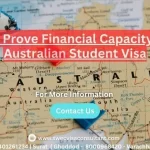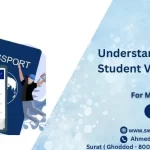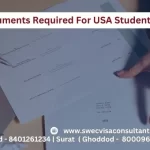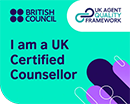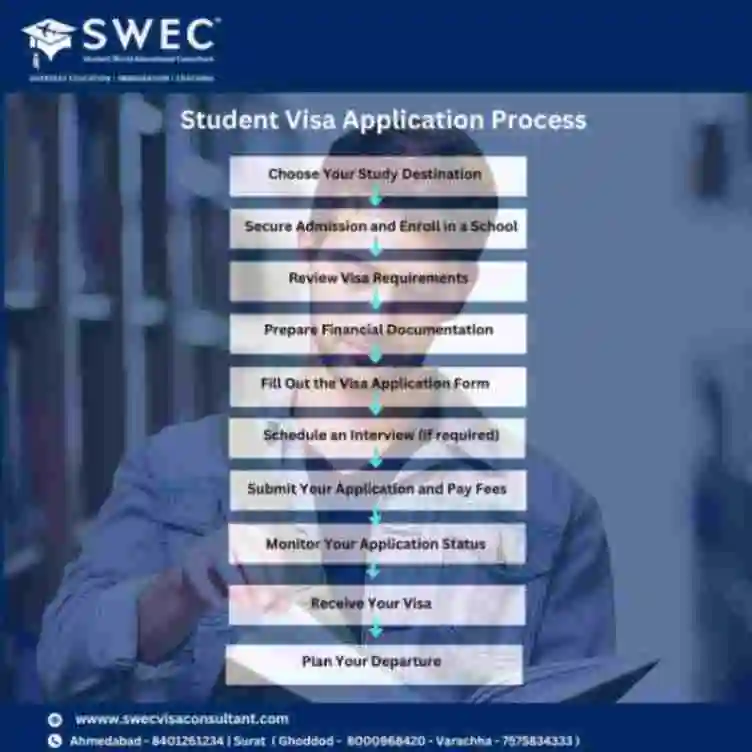
The quest for international education is growing, and securing a student visa is the crucial first step for aspiring students. This essential document allows you to embark on your academic journey in a foreign country. Understanding the visa application process is key to unlocking educational opportunities abroad.
Navigating the visa application can be challenging, but don’t worry – SWEC Visa and Immigration has created this comprehensive step-by-step guide to help you through every phase of your study abroad experience.
Understanding the Student Visa
A student visa is an official endorsement from a government that permits individuals from other nations to reside in the host country for educational purposes. This visa allows international students to pursue their studies while ensuring compliance with the host country’s regulations.
Understanding Different Types of Student Visas
- Short-Term Student Visas: Typically granted for short courses such as language studies or diploma programs, usually limited to 90 days.
- Long-Term Student Visas: For degree programs exceeding three months, including undergraduate, postgraduate, or doctoral studies, and potentially internships and certificate programs.
Visa Classification Based on Type of Program or Student
Student visas can also be classified based on the nature of the program or the student category:
- Undergraduate, Graduate, or Doctoral Visas: Depending on the level of the degree.
- Exchange Student Visas: For students participating in exchange programs, regardless of duration.
- Vocational or Diploma Course Visas: Specific to students enrolled in non-degree courses.
People also read: Guide to Getting Student Visa in Canada
Student Visas for Popular Study Destinations
Here are the types of student visas for some of the most sought-after study destinations:
US Student Visa
Known as the F1 visa, this US student visa is initially valid for one year. If your program extends beyond this period, you must renew your F1 visa. To be eligible, you must first register with the Student Exchange Visitor Program (SEVP). There are additional visa options available for students in the US.
UK Student Visa
For a UK student visa, your course must meet specific requirements based on whether you are a full-time or part-time student. Proof of language proficiency is also required.
Australian Student Visa
The subclass 500 visa is issued for up to five years for students enrolled in Australian institutions. You must provide a language certificate to qualify. The duration of your stay with this visa depends upon the type and duration of your course. You must have been enrolled in an Australian education provider prior to your visa application
Germany Student Visa
German student visas can be valid for three to six months, depending on your study plans. After entering Germany on a long-term student visa, you can apply for a temporary student residence permit, eliminating the need for a visa.
Canadian Student Visa
This visa is valid for the duration of your study program plus an additional 90 days to manage your departure arrangements. You must be enrolled in a Canadian institution and meet the financial requirements for a student visa.
When Should You Apply for a Student Visa?
Studying abroad requires careful and strategic planning. It’s essential to keep university deadlines in mind and work backwards from these dates. Begin by scheduling your English proficiency tests as required by the university and ensure all necessary documents are prepared for a smooth application process. Applying for your student visa 1-3 months in advance is advisable to avoid last-minute complications. If you need financial aid, scholarships, or education loans, allocate additional months for these applications as they take more time to process.
Key Documents Required for Student Visa Applications
Each country has specific requirements based on its immigration laws, but some documents are commonly required:
- Letter of Acceptance: From an accredited educational institution.
- Valid Passport: Must have an expiration date that extends beyond your stay.
- Financial Proof: Evidence of funds to cover tuition and living expenses.
- Visa Application Form: Completed accurately with the required information.
- Health Insurance and Medical Certificates: As specified by the host country.
- Language Proficiency Test Results: Such as TOEFL or IELTS.
- Photographs: Passport-sized, meeting visa application requirements.
- Proof of Intent to Return: Evidence of ties to your home country.
- Clearance Certificates and Background Checks: If required.
- Educational Qualifications and Academic Records: Relevant to your intended course of study.
Step-by-Step Guide to Applying for a Student Visa
Step 1: Choose Your Study Destination
Start by selecting your preferred study destination and researching its specific visa requirements. This includes identifying the type of student visa needed and any prerequisites. Popular destinations and their visa requirements include:
- USA Student Visa
- UK Student Visa
- Canadian Student Visa
- German Student Visa
- Australian Student Visa
Step 2: Secure Admission and Enroll in a School
Gain admission to an accredited educational institution by meeting their documentation and admission criteria. An acceptance letter from the institution is crucial for your visa application.
Step 3: Review Visa Requirements
Thoroughly review the visa requirements provided by the embassy or consulate of your chosen country. Gather all necessary documents, such as proof of acceptance, financial statements, medical records, and a valid passport.
Step 4: Prepare Financial Documentation
Show proof of your financial ability to support yourself during your studies. This typically involves demonstrating funds to cover tuition and living expenses and may include sponsorship or scholarship details.
Step 5: Fill Out the Visa Application Form
Complete the student visa application form accurately. Ensure all information is correct and include any additional required documents before submission.
Step 6: Schedule an Interview (if required)
Some countries require a visa interview. Schedule this appointment well in advance, prepare thoroughly by reviewing common questions, and ensure all necessary documents are ready.
Step 7: Submit Your Application and Pay Fees
Submit your completed application along with the required documentation to the appropriate embassy or consulate. Pay the visa application fee according to the guidelines.
Step 8: Monitor Your Application Status
Track your application status through the channels provided by the embassy or consulate. Respond promptly to any additional inquiries or requests for information.
Step 9: Receive Your Visa
Upon approval, collect your visa either in person or through a designated courier service, ensuring all details are accurate.
Step 10: Plan Your Departure
With your visa secured, arrange your travel, book flights, and familiarize yourself with the host country’s pre-departure requirements.
People also read: Your Guide to International English Language Testing System (IELTS)
Guidelines for Maintaining Your Student Visa
To avoid visa cancellation, adhere strictly to student visa rules:
- Work only within permitted hours, usually up to 20 hours per week, typically in on-campus jobs.
- Attend all classes unless there’s an emergency, with absences reported.
- Maintain a specific GPA if you are on a scholarship.
- Depart the country before your visa expires.
- Do not apply for permanent residence under a student visa.
Common Causes of Visa Rejections
Numerous factors can lead to visa rejection. The visa application process is meticulous, with every detail scrutinized against documentary evidence. Therefore, it’s crucial to exercise caution while completing your visa application form and responding to questions during your visa interview.
Incomplete Application
Your visa application may face rejection if mandatory fields in the form are left blank. It’s essential to fill in all details accurately and thoroughly review the form for errors before submission.
Violation of Rules
Adherence to visa application regulations set by the office managing visas and the Ministry of External Affairs is crucial. Any deviation from these rules, including improper documentation, can result in visa rejection.
Incomplete Travel Details
Submission of comprehensive travel plans, especially for trips spanning multiple countries, is necessary. Inaccurate or incomplete travel details are a common reason for visa rejections.
Insufficient Travel Insurance
Many countries mandate travel insurance for immigrants or tourists. Failure to provide adequate coverage can lead to visa rejection.
Unclear Purpose of Travel
A clear and documented purpose for travel is essential. Ambiguity or lack of supporting evidence can result in visa rejection.
Passport Issues
Issues such as expired passports, insufficient pages, or nearing expiry dates can lead to visa rejection.
Application Timings
Timing your visa application correctly is crucial. Applying too close to your travel dates can increase the likelihood of rejection.
Insufficient Funds
Financial stability and meeting predefined thresholds are crucial. Inadequate funds in your bank account can lead to visa rejection.
Crime History
A criminal record can result in visa rejection.
Sponsor Credibility
The credibility of your sponsor is scrutinized, including their legal status, income, and tax history.
Return Intent
Providing proof of intent to return to your home country is necessary.
Past Records in Destination Country
Previous involvement in unacceptable activities or strained relations with the destination country can lead to rejection.
Health Issues
Infectious diseases or failure to meet health requirements can result in visa rejection.
Visa Interview Outcome
The outcome of your visa interview is critical. Transparency and honesty during the interview are essential to avoid rejection.
People also read: All You Need to Know About the TOEFL Exam
Tips to Avoid Student Visa Rejection
Securing a student visa is crucial for studying abroad, and international applicants should be aware of common pitfalls to prevent their applications from being rejected. Here are essential tips to help avoid student visa rejections:
- Apply Within the Correct Timeframe: Submit your student visa application well in advance to ensure it is processed in time. This prevents any delays that could impact your ability to start classes on schedule.
- Attend Interviews with Confidence: If an interview is required, approach it with confidence and dress appropriately. First impressions matter, so present yourself professionally.
- Provide Clear and Honest Answers: During the visa interview, answer questions directly and honestly. Avoid giving vague or unclear responses, as this can raise doubts about your intentions.
- Demonstrate Temporary Intent: Clearly convey that you intend to study and return to your home country after completing your education. Avoid suggesting that you plan to stay long-term in the host country.
- Prove Strong Ties to Your Homeland: Show evidence of strong connections to your home country, such as family ties, job prospects, or property ownership. This reassures visa officers of your intent to return.
- Ensure Information Accuracy: Provide accurate and consistent information throughout your application and interview. Any discrepancies can lead to rejection.
- Show Financial Stability: Be prepared to demonstrate your financial ability to cover tuition and living expenses. Proper financial documentation is a critical component of your visa application.
- Highlight Your Suitability: Present yourself as a deserving and responsible student who will benefit from the education abroad. Emphasize your academic qualifications and commitment to your studies.
By following these tips, you can enhance your chances of obtaining a student visa and begin your educational journey abroad smoothly. For personalized assistance, consult with SWEC Visa and Immigration experts who can guide you through the entire process.
What to do if your Student Visa is Denied?
If your student visa is rejected, reapply after understanding and addressing the reasons for denial. Act quickly to avoid missing your study program deadlines and ensure all issues are resolved before resubmitting your application.
Conclusion
Understanding the specifics of the student visa application process, along with its conditions and responsibilities, is essential for any international student. Each country has unique requirements, so it’s crucial to be well-informed about the guidelines of your chosen study destination. Ensure you meet all necessary conditions before applying for a student visa, and embark on your educational journey with confidence.
Obtaining a student visa can seem daunting, but with the right preparation and guidance, you can navigate the process with confidence. Here at SWEC, Ahmedabad’s leading immigration and visa consultant, we are dedicated to helping you achieve your international education goals.
Don’t let visa complexities hinder your dreams of studying abroad. Partner with SWEC and turn your educational aspirations into a reality!
Call us or Reach to us on Whatsapp to schedule a free consultation.


